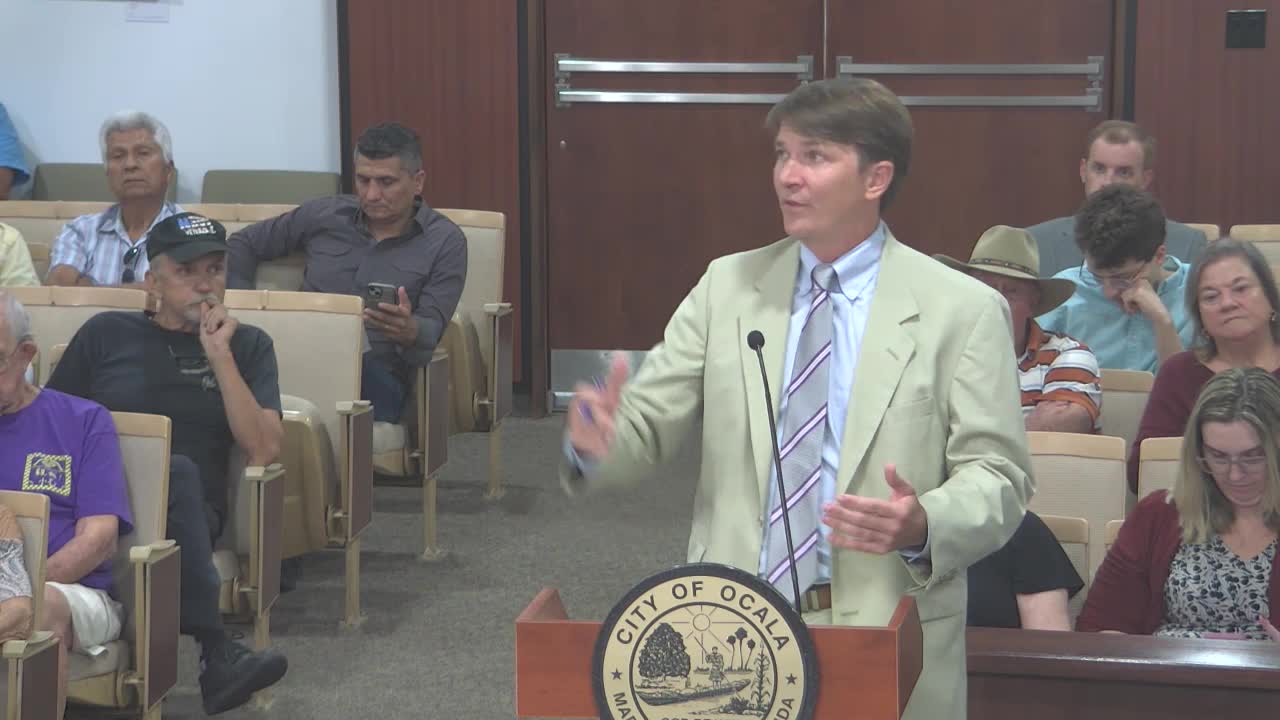Ocala Residents Oppose Plan for 30 Units Per Acre Apartment Development
September 08, 2025 | Ocala, Marion County, Florida
This article was created by AI summarizing key points discussed. AI makes mistakes, so for full details and context, please refer to the video of the full meeting. Please report any errors so we can fix them. Report an error »

The Ocala Planning & Zoning Commission meeting on September 8, 2025, highlighted significant concerns regarding proposed residential developments in the area, particularly the potential increase in housing density and its implications for local infrastructure.
One of the most pressing issues discussed was a proposal to increase the allowable density from 12 units per acre to 30 units per acre for a new development. This change would allow for taller buildings, with plans suggesting structures reaching up to ten stories. Community members expressed strong opposition to this increase, citing the current availability of 3,800 residential units in Ocala, with 450 already on the market in Northeast Ocala. Residents questioned the necessity of adding another 5,000 units, fearing that such developments would exacerbate existing traffic issues and lead to an oversupply of housing.
Public comments revealed a shared concern about the impact of increased density on traffic congestion. Residents noted that the area is already experiencing significant traffic from nearby developments and industrial complexes, raising alarms about safety and accessibility. One resident reported multiple accidents at a problematic intersection, emphasizing the need for careful consideration of traffic flow before approving new projects.
Additionally, residents from Bear Track Ranch expressed worries about the proximity of new developments to their properties, requesting a natural buffer zone to maintain privacy and security. They highlighted the importance of preserving the area's wooded landscape and wildlife habitats, which could be threatened by high-density construction.
As the meeting concluded, the commission acknowledged the community's concerns but reiterated that the current land use designation for the property allows for medium density development. The discussions underscored the ongoing tension between growth and community needs in Ocala, setting the stage for further deliberations on how to balance development with the preservation of local quality of life. The commission's next steps will be crucial in determining the future landscape of Ocala and addressing the residents' concerns about density, traffic, and environmental impact.
One of the most pressing issues discussed was a proposal to increase the allowable density from 12 units per acre to 30 units per acre for a new development. This change would allow for taller buildings, with plans suggesting structures reaching up to ten stories. Community members expressed strong opposition to this increase, citing the current availability of 3,800 residential units in Ocala, with 450 already on the market in Northeast Ocala. Residents questioned the necessity of adding another 5,000 units, fearing that such developments would exacerbate existing traffic issues and lead to an oversupply of housing.
Public comments revealed a shared concern about the impact of increased density on traffic congestion. Residents noted that the area is already experiencing significant traffic from nearby developments and industrial complexes, raising alarms about safety and accessibility. One resident reported multiple accidents at a problematic intersection, emphasizing the need for careful consideration of traffic flow before approving new projects.
Additionally, residents from Bear Track Ranch expressed worries about the proximity of new developments to their properties, requesting a natural buffer zone to maintain privacy and security. They highlighted the importance of preserving the area's wooded landscape and wildlife habitats, which could be threatened by high-density construction.
As the meeting concluded, the commission acknowledged the community's concerns but reiterated that the current land use designation for the property allows for medium density development. The discussions underscored the ongoing tension between growth and community needs in Ocala, setting the stage for further deliberations on how to balance development with the preservation of local quality of life. The commission's next steps will be crucial in determining the future landscape of Ocala and addressing the residents' concerns about density, traffic, and environmental impact.
View full meeting
This article is based on a recent meeting—watch the full video and explore the complete transcript for deeper insights into the discussion.
View full meeting